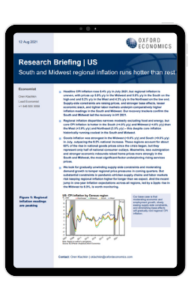US South and Midwest regional inflation runs hotter than rest

Headline CPI inflation rose 5.4% y/y in July 2021, but regional inflation is uneven, with prices up 5.9% y/y in the Midwest and 5.8% y/y in the South on the high end and 5.2% y/y in the West and 4.3% y/y in the Northeast on the low end. Supply-side constraints are raising prices, and stronger base effects, lesser economic slack, and tighter labor markets underpin comparatively higher inflation readings in the South and Midwest. Our recovery trackers confirm the South and Midwest led the recovery in H1 2021.
What you will learn:
- Regional inflation disparities narrows modestly excluding food and energy, but core CPI inflation is hotter in the South (+4.8% y/y) and Midwest (+4.6% y/y) than the West (+3.9% y/y) and Northeast (3.5% y/y) – this despite core inflation historically running coolest in the South and Midwest.
- Goods inflation was strongest in the Midwest (+9.6% y/y) and South (+9.5% y/y) in July, outpacing the 9.2% national increase. These regions account for about 60% of the rise in national goods prices since the crisis began, but they represent only half of national consumer outlays.
- We look for gradually unwinding supply-side constraints and moderating demand growth to temper regional price pressures in coming quarters. But substantial constraints in pandemic-stricken supply chains and labor markets risk keeping regional inflation higher for longer than we expect.
Tags:
Related Services

Post
US Rolls Up Welcome Mat for International Travel
Research Briefing US South and Midwest regional inflation runs hotter than rest Trump tariffs set to raise effective rate above 1930s levels.
Find Out More
Post
Initial takeaways from Trump’s ‘Liberation Day’ announcement
In two or three years' time, US imports could fall by around 15% due to discounted reciprocal tariff hikes.
Find Out More